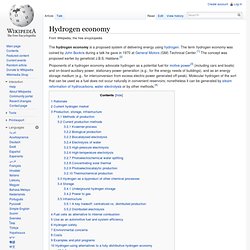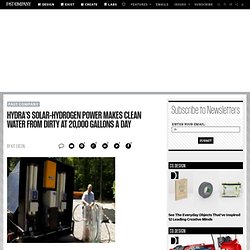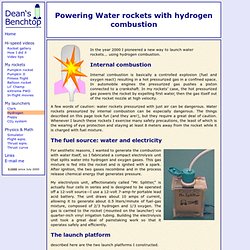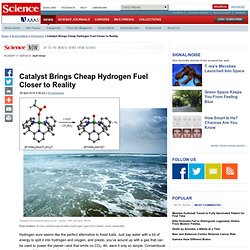

Buy a Watertorch - Watertorch.com. Mimicking photosynthesis path to solar-derived hydrogen fuel. Inexpensive hydrogen for automotive or jet fuel may be possible by mimicking photosynthesis, according to a Penn State materials chemist, but a number of problems need to be solved first.

"We are focused on the hardest way to make fuel," said Thomas Mallouk, Evan Pugh Professor of Materials Chemistry and Physics. New catalyst of platinum nanoparticles could lead to conk-out free, stable fuel cells. In the quest for efficient, cost-effective and commercially viable fuel cells, scientists at Cornell University's Energy Materials Center have discovered a catalyst and catalyst-support combination that could make fuel cells more stable, conk-out free, inexpensive and more resistant to carbon monoxide poisoning.

The research, led by Héctor D. Abruña, Cornell professor of Chemistry and Chemical Biology and director of the Energy Materials Center at Cornell; Francis J. DiSalvo, Cornell professor Chemistry and Chemical Biology; Deli Wang, post doctoral researcher; Chinmayee V. Finding answers century-old questions about platinum's catalytic properties. Researchers now understand more about why platinum is so efficient at producing power in hydrogen fuel cells.

"Understanding platinum's properties for speeding up chemical reactions will potentially enable scientists to create significantly cheaper synthetic or metal alloy alternatives for use in sustainable devices like fuel cells," says Gregory Jerkiewicz, a professor in the Department of Chemistry who led the groundbreaking study, published in the journal Langmuir. Dr. Jerkiewicz's research team has found that when platinum is used in reactions involving hydrogen it develops an embedded layer of hydrogen just one atom thick.
This gives the platinum hydrophobic or water-repelling qualities, meaning that stray water molecules inside the fuel cell cannot bond strongly with the surface of the platinum. Hydrogen fuel tech gets boost from low-cost, efficient catalyst. May 3, 2011 — Scientists have engineered a cheap, abundant alternative to the expensive platinum catalyst and coupled it with a light-absorbing electrode to make hydrogen fuel from sunlight and water.

The discovery is an important development in the worldwide effort to mimic the way plants make fuel from sunlight, a key step in creating a green energy economy. It was reported in Nature Materials by theorist Jens Nørskov of the Department of Energy's SLAC National Accelerator Laboratory and Stanford University and a team of colleagues led by Ib Chorkendorff and Søren Dahl at the Technical University of Denmark (DTU). Chance discovery may revolutionize hydrogen production. Producing hydrogen in a sustainable way is a challenge and production cost has so far proven to be too high.

Now a team led by EPFL Professor Xile Hu has discovered that a molybdenum based catalyst is produced at room temperature, inexpensive and efficient. The results of the research are published online in Chemical Science. An international patent based on this discovery has just been filled. Existing in large quantities on Earth, water is composed of hydrogen and oxygen. It can be broken down by applying an electrical current; this is the process known as electrolysis.
Industrial prospects The new catalysts exhibit many advantageous technical characteristics. It's only by chance that Daniel Merki, Stéphane Fierro, Heron Vrubel and Xile Hu made this discovery during an electrochemical experience. The next stage is to create a prototype that can help to improve sunlight-driven hydrogen production. Hydrogen economy. The hydrogen economy is a proposed system of delivering energy using hydrogen.

The term hydrogen economy was coined by John Bockris during a talk he gave in 1970 at General Motors (GM) Technical Center.[1] The concept was proposed earlier by geneticist J.B.S. Haldane.[2] Proponents of a hydrogen economy advocate hydrogen as a potential fuel for motive power[3] (including cars and boats) and on-board auxiliary power, stationary power generation (e.g., for the energy needs of buildings), and as an energy storage medium (e.g., for interconversion from excess electric power generated off-peak). Molecular hydrogen of the sort that can be used as a fuel does not occur naturally in convenient reservoirs; nonetheless it can be generated by steam reformation of hydrocarbons, water electrolysis or by other methods.[4] Rationale[edit] Elements of the hydrogen economy In the current hydrocarbon economy, transportation is fueled primarily by petroleum.
Hydrogen. S physics-defying promise: Cheap power from water - Jul. 2, 2008. (Fortune Small Business) -- Imagine being able to convert water into a boundless source of cheap energy.

That's what BlackLight Power, a 25-employee firm in Cranbury, N.J., says it can do. The only problem: Most scientists say that company's technology violates the basic laws of physics. Such skepticism doesn't daunt Dr. Hydra's Solar-Hydrogen Power Makes Clean Water From Dirty at 20,000 Gallons a Day. For the one in every eight souls around the world lacking access to pure drinking water, how about this: A solar-powered water purification system that spits out pure water, hydrogen and, just for kicks, electricity too.

Could it get any better than that? The device is called Hydra, and like its many-headed mythological namesake it truly serves a multitude of purposes: As its press release notes, "imagine a single trailer-mounted device that turns scum into over 20,000 gallons of pure water a day, stores electricity better than a battery, makes medical-grade oxygen, and runs on the sun. " That's quite enough benefits from one device, thankyouverymuch. It works on a very simple, long-understood principle: electrolysis. The products are exactly what you may expect: Oxygen to help with medical problems, electricity for any number of purposes, and pure water at a phenomenal rate. But how does Hydra compare with other systems out there that offer some of the same benefits? Working With Water - The Essential Element unveils the Hydra water purifier. Hydra - Solar Hydrogen Powered Water Purification. Performance Data - The Hydra - Solar, Hydrogen Fuel Cell Powered Water Purification.
Wwsystem.pdf (application/pdf Object) Dean's Benchtop: Hydrogen Power. In the year 2000 I pioneered a new way to launch water rockets... using hydrogen combustion.

Internal combustion Internal combustion is basically a controlled explosion (fuel and oxygen react) resulting in a hot pressurized gas in a confined space. In automobile engines the pressurized gas pushes a piston connected to a crankshaft. In my rockets’ case, the hot pressurized gas powers the rocket by expelling first water, then the gas itself out of the rocket nozzle at high velocity. A few words of caution: water rockets pressurized with just air can be dangerous. The fuel source: water and electricity For aesthetic reasons, I wanted to generate the combustion with water itself, so I fabricated a compact electrolysis unit that splits water into hydrogen and oxygen gases. My electrolysis unit, affectionately called “Mr. The launch platform described here are the two launch platforms I constructed. Catalyst Brings Cheap Hydrogen Fuel Closer to Reality. Hydrogen sure seems like the perfect alternative to fossil fuels.

Just zap water with a bit of energy to split it into hydrogen and oxygen, and presto, you’ve wound up with a gas that can be used to power the planet—and that emits no CO2. Ah, were it only so simple. Conventional water-splitting catalysts that make hydrogen gas are either too expensive, too frail, or too finicky to work in water alone. Now, however, researchers report that they’ve created a new molybdenum-based catalyst that cranks out the hydrogen, is cheap to make, works in water, and is robust. The catalyst isn’t perfect, as it requires too much energy to generate hydrogen. Generating hydrogen gas (H2) isn’t difficult. None of this was initially on the mind of Jeffrey Long, a chemist at the University of California, Berkeley. Solar Power Splits Water Into Hydrogen And Oxygen Using Unique Method. Engineers at Washington University in St. Louis have developed a unique photocatalytic cell that splits water to produce hydrogen and oxygen in water using sunlight and the power of a nanostructured catalyst.
The group is developing novel methodologies for synthesis of nanostructured films with superior opto-electronic properties. One of the methods, which sandwiches three semiconductor films into a compact structure on the nanoscale range, is smaller, more efficient and more stable than present photocatalytic methods, which require multiple steps and can take from several hours to a day to complete.
Automotive Engineers Team Up to Improve Energy-Saving Technology. July 30, 2016 — An international team has devised a method for achieving 1 terapascal of static pressure - vastly higher than any previously ... read more July 29, 2016 — Scientists have tailored extremely small wires that carry light and electrons. These new structures could open up a potential path to smaller, lighter, or more efficient devices, they ... read more July 29, 2016 — Climate and energy scientists have developed a new method to pinpoint which electrical service areas will be most vulnerable as populations grow and temperatures ... read more Replication Project Investigates Self-Control as Limited Resource.